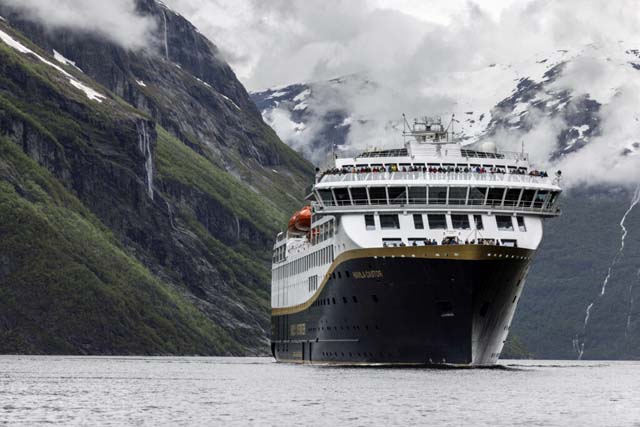Havila Kystruten`s passenger ship ‘Havila Castor’ has proved it can sail in and out of the Geiranger fjord in zero-emission mode with help from the largest battery pack installed onboard a commercial vessel.
Geir Bjørkeli, CEO Corvus Energy, said: “This is a milestone for Corvus Energy and a big step for the decarbonisation of shipping. For the first time in history, a large passenger ship has sailed this route silent and emission-free. This proves that technology is ready even for large ships to operate in zero-emission mode for longer periods of time.”
Havila Castor is one of four identical ships built for Havila Kystruten to operate on the coastal route between Bergen and Kirkenes in the North of Norway. The full round trip takes 11 days. Corvus has delivered a complete 6.1 MWh Orca battery system for each of the vessels.
Bent Martini, CEO Havila Kystruten, said: “The world’s most beautiful coastline now has the world’s most environmentally friendly coastal ship. By continuous focus on the environment and the best passenger experience, we have managed to set a new standard for the cruise and passenger industry. The first trip on battery alone went exceptionally well and we see that we can achieve even more by testing and fine tuning all the systems onboard. Feedback from our customers has been phenomenal.”
Energy efficiency has been key through the entire design phase. Ship design, equipment and smart control systems are mainly delivered by the HAV Group and its subsidiaries. HAV Design has done the ship design, Norwegian Greentech has delivered the low energy, low footprint ballast water cleaning system, Norwegian Electric Systems has been system integrator and supplied the hybrid gas-electric propulsion system inclusive battery system, generators with complete switchboards, frequency converters and control systems in addition to the new Raven INS. The Raven INS is a fully integrated bridge system included smart features such as data hoarding and analysis to continuously develop better and more efficient operations.
The propulsion system onboard all four sister vessels are also prepared for the installation of next-generation technology using hydrogen and fuel cells by HAV Hydrogen.
Th entire trip from the city of Ålesund and back took nine hours where more than three hours were on battery only. Feedback from Havila technical personnel on board was that the battery performed beyond expectations. After three hours on battery only, they had close to 40% of the battery capacity left which means four hours is no problem. The energy storage systems along with all other environmental technologies on the ship reduce CO2 emissions by around 30% and NOx emissions by 90%. With the gradual blending of biogas, emissions of CO2 will be reduced to 50% in 2023 and 80% in 2024.
The second in the series of identical vessels has been named Havila Capella, and the other two ships, Havila Polaris and Havila Pollux, will be delivered to Havila Kystruten by the end of 2022.



